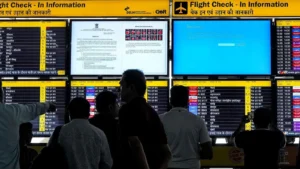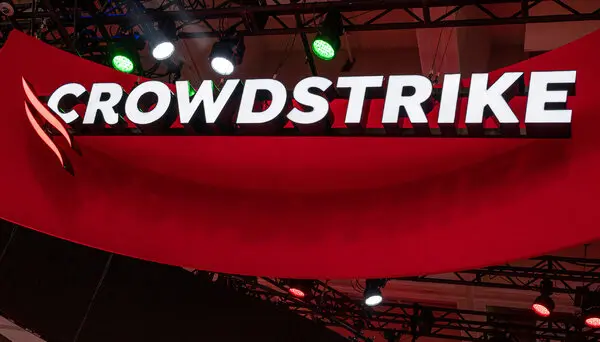The IT disruption, which caused many PCs to display blue error displays, has halted flights.
Due to the manual check-in process, airports worldwide saw long lines, delays, and cancelled flights.
The issue was brought on by an upgrade to the antivirus program, which is intended to defend Microsoft Windows devices against harmful threats, according to the cybersecurity company Crowdstrike.
According to Microsoft, in order to address “the lingering impact” of the outage, “mitigation action” is being taken. This is an overview of our current knowledge.

Why did the outage occur?
There’s still some confusion here. Known for creating antivirus software, Crowdstrike aims to stop hackers from causing exactly this kind of disruption.
George Kurtz, the CEO of Crowdstrike, claims that a recent update flaw is the reason behind the problems, which are exclusive to Windows PCs and do not affect any other operating systems.
“The issue has been identified, isolated and a fix has been deployed,” he stated.
“This is not a security incident or cyber-attack.”
It’s unclear exactly what went wrong with the update, but since one proposed repair calls for removing one file, it’s possible that a single rogue file is the cause of all the chaos.
What is Crowdstrike?
That a corporation not exactly known for household names, Crowdstrike, can be at the center of such global chaos serves as a reminder of the complexity of our contemporary digital infrastructure.

The Austin, Texas-based corporation is listed on the US stock exchange and can be found in the S&P 500 and the tech-heavy Nasdaq indexes.
It’s a relatively new company, much like many modern tech companies. Just 13 years have passed since its founding, but it already employs close to 8,500 people.
Being a cyber-security service provider, it frequently gets called in to handle hack attack aftermath.
It has been investigating a number of high-profile cyberattacks, including the 2014 hacking of Sony Pictures’ computer system.
However, this time, a company that typically contributes to the solution of IT issues has created one due to a faulty software update.
In its most recent financial report, Crowdstrike reported having close to 24,000 clients in total. That is a sign of the problem’s magnitude as well as the potential challenges in resolving it.
Since each of those clients is a sizable organization in itself, it is difficult to determine the precise number of machines impacted.
When will it be fixed?
It might take a while. Speaking to NBC News, Mr. Kurtz of Crowdstrike stated that the company’s “mission” was to ensure that each and every one of its clients fully recovered from the outage.
“We’re deeply sorry for the impact that we’ve caused to customers, to travellers, to anyone affected by this, including our companies,” he stated.
Subsequently, he stated to CNBC that although certain systems can be rectified rapidly, others may require several hours or even longer.
Crowdstrike has released their update. But, insiders claim that it will need to be administered individually to every impacted device.
Computers will need to be manually restarted in safe mode, which will be extremely difficult for IT teams worldwide.
What’s the solution?
It’s crucial to remember that this outage is affecting businesses, not individuals. Personal electronics like your home computer or smartphone are not likely to have been impacted.
Microsoft is suggesting that users try the tried-and-true solution of turning their device off and back on up to fifteen times in order to restart it.
According to the tech giant, some users of virtual machines—PCs in which the computer and screen are not in the same location—have found success with this.
Reboots may be necessary in several cases (up to 15 have been reported), but generally feedback indicates that they are a useful troubleshooting step at this point.
Additionally, it is advising clients with more advanced computer skills to remove a specific file—a remedy that a CrowdStrike employee has been posting on social media.

However, experts and IT professionals—not everyday users—are the target audience for this repair.
Which airports have been affected?
Although the issues are global in scope, Australia was the first to identify them. The airline industry may be most negatively impacted, since over 3,300 flights have been canceled worldwide.
There were delays at UK airports, including lengthy lines at Gatwick and Stansted in London.
When Ryanair’s website came back online, it informed customers that it had been “forced to cancel a small number of flights today (19 July)” and gave them advice on what to do.
A number of flights were also canceled by British Airways.
For a significant portion of Friday, flights operated by several US airlines, most notably United, Delta, and American Airlines, were grounded worldwide. Virgin Australia and Jetstar, two Australian airlines, also experienced flight delays or cancellations.
Delhi, Amsterdam, and Tokyo airports were all affected. Globally, payment systems, banks, and healthcare providers have also been impacted by the issues.
Passengers were advised to anticipate delays by railway firms, including the largest in Britain, which operates Southern, Thameslink, Gatwick Express, and Great Northern.
The 911 emergency service was impacted in Alaska, and Sky News was unable to broadcast for several hours on Friday morning.



Pingback: Crowdstrike Upgrade
Pingback: CrowdStrike IT outage impacted 8.5 million Windows devices